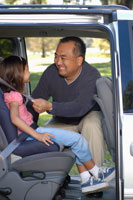Don’t ditch your child’s booster seat too soon
In the last 20 years, America has seen a 71 percent drop in infant fatality rates from vehicle crashes, thanks to the proper use of car seats. For children ages 5 to 12, vehicle crashes remain the number one cause of death in California, according to a California Department of Public Health study.
The reason? Many parents stop using booster seats for their children too soon. California law requires children stay in a child or booster seat until they are 6 years old or weigh at least 60 pounds. However, at that size, kids are still too small for an adult safety belt.
Booster seats represent the third stage in your child’s car-seat evolution. Kids are ready for a booster when they can no longer be safely restrained by their forward-facing seat’s five-point harness. Check your car-seat manual to determine when that is, because every seat and every child is different.
Generally, most kids are not ready for a booster until they’re around 4 years old and weigh 40 pounds, but that’s not always the case, says Myra Weiman, safety service manager of the Foundation for Safety and Education, a nonprofit affiliate of the American Automobile Association (AAA). The variables depend upon the child’s weight, height, how they fit in the seat and the design of the seat.
“The purpose of the booster is the lift it gives to make the seat belt fit them like an adult,” Wieman says. The shoulder strap should lay flat against the shoulder and chest (not on the neck), while the lap belt secures the hips and upper thighs, sparing the vulnerable abdomen.
There are several kinds of booster seats currently on the market: back included, backless, and adjustable booster seats. To best determine which type is the best for your child, consider what car it will be used in, how tall and heavy your child is and the seat’s specifications.
For example, if your car’s back seat does not have a headrest, you should look for a booster seat with a back headrest, says Jackie Leach, a certified passenger safety instructor for the National Highway Traffic Safety Administration (NHTSA). While some of the convertible seats have five-point harnesses that can be used for children up to 65 pounds, if your child’s shoulders are higher than the slots where the straps come through the back, your child would not be adequately protected in the event of a crash, even if he weighs less than 65 pounds.
If you choose to go with a convertible booster seat (some on the market can be used from 20 to 100 pounds) it’s very important to follow the guidelines in the manual to determine how you should configure the seat as your child grows. The seat manual will specify weight and height limits for each arrangement.
For young children who are physically big enough for a booster but not mature enough to sit still, use the seatbelt in automatic locking mode. To do this, insert the seat belt in the clip, then pull the seat belt all the way out from the top lead, says Leach. Release it until it tightens against your child’s shoulder. If you’re driving a car made before 1995, you will need to get a locking clip for this.
Swapping out the booster too soon leads to what healthcare providers call “safety belt syndrome” in children: lower spinal cord injuries and abdominal organ injuries to the liver, kidneys, spleen, intestines and bladder when children are involved in a crash. Children from 4 to 8 years old are 60 percent less likely to be injured in a crash when in a booster seat compared with when using a seat belt alone, according to the AAA Foundation for Traffic Safety.
NHTSA guidelines recommend that kids stop using a booster when they are 80 pounds and approximately four feet, nine inches tall. Keep in mind, however, that seat belts are deigned for the average 165-pound adult male. How your child fits in the vehicle seat should be the deciding factor.
“Their fanny should be all the way back against the seat while their knees are comfortably folded over the edge of the vehicle seat,” Wieman says. The shoulder and lap belt should not rest on the neck and abdomen. Check to see if you can adjust the height of the seat belt lead for a better fit over the shoulder.
Once kids have graduated from a booster seat, they should sit in the back seat until they are 13 years old. According to the American Academy of Pediatrics, the force of a front airbag deployment can cause children serious injuries, even death.
For expert advice, find a NHTSA Certified Child Passenger Safety Technician and Instructor through www.seatcheck.org or call 866-SEAT-CHECK for a list of inspection stations in the San Diego area.
________________
Lori Crawley is a freelance writer










